raymond f. gasser
ATLAS OF HUMAN EMBRYOS
Copyright © 1975 RF Gasser, PhD. All rights reserved. Reproduced with permission.Chapter II (Pages 7-13)
the second week of life
bilaminar and early trilaminar period
I. EMBRYO PROPER
Figs. 2–1, 2–2, 2–3, 2–4, 2–5, 2–6The blastocyst becomes firmly embedded in the endometrium (uterine mucosa). It establishes a relationship with the maternal blood vessels whereby it receives food and eliminates waste products. Both the embryo proper and the extraembryonic membranes grow rapidly. A fibrous coagulum forms at the site of penetration of the endometrium and is soon covered over entirely by epithelial cells completing the implantation process.
Early in the second week the embryo appears as a bilaminar or two-layered disc with an upper layer called the epiblast and a lower layer called the endoderm. The epiblast is thick and composed of regularly arranged columnar cells. It is continuous at its periphery with the amnion (see below). The endoderm is thin and made up of irregularly arranged, polyhedral cells. It is continuous at its periphery with the yolk sac (see below).
By the end of the second week the primitive streak becomes evident in the epiblast near the caudal end of the embryonic disc. It is produced by the epiblast and begins as a clump of cells in the midline between the epiblast and the endoderm. This clump of cells represents the first appearance of embryonic mesoderm. After the primitive streak produces embryonic mesoderm, the epiblast layer is referred to as ectoderm.
II. EXTRAEMBRYONIC MEMBRANES
Figs. 2–1, 2–2, 2–3, 2–4, 2–5, 2–6A. TROPHOBLAST
As the trophoblast invades deeply into the endometrium, the maternal capillaries in the vicinity become congested with blood cells and dilate to form sinusoids. The syncytial trophoblast erodes the wall of the sinusoids and becomes continuous with their endothelial lining.
Spaces called lacunae develop in the syncytial trophoblast by fusion of intracytoplasmic vacuoles. The lacunae join together to form an intercommunicating network that becomes continuous with the maternal blood vessels. Maternal blood begins to flow through the lacunar network, establishing the early uteroplacental circulation.
The cellular trophoblast is located on the inner or embryo side of the syncytial trophoblast. Cells called extraembryonic mesoblasts form along the inner surface of the cellular trophoblast. Their origin is controversial.
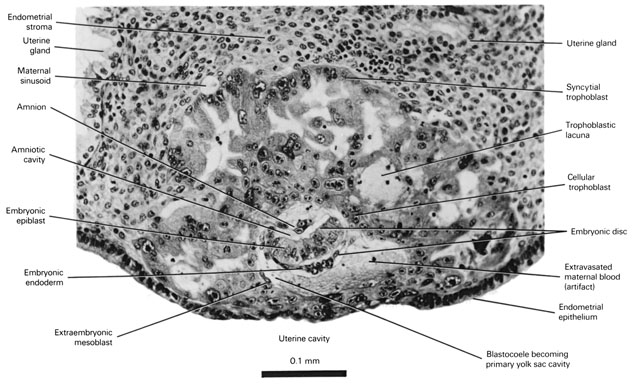
FIG. 2–1
The 9-day previllous embryo (bilaminar blastocyst)
Stage 5
Age 9 days
Carnegie collection 8004
Reference
Hertig AT, Rock J: Two human ova of the pre-villous stage, having a developmental age of about seven and nine days respectively. Contrib Embryol Carnegie Instn 31:65–84, 1945 [printable version of FIG 2-1]
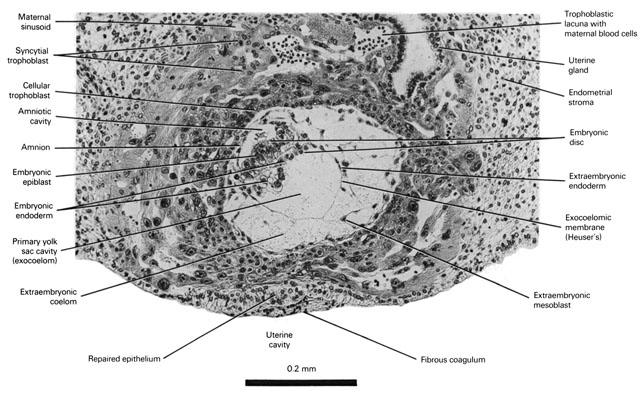
FIG. 2–2
The 11-day previllous embryo (late bilaminar blastocyst)
Stage 5
Age 11 days
Carnegie collection 7699
Reference
Hertig AT, Rock J: Two human ova of the pre-villous stage, having an ovulation age of about eleven and twelve days respectively. Contrib Embryol Carnegie Instn 29:127–156, 1941 [printable version of FIG 2-2]
B. CHORION
By the end of the second week the extraembryonic mesoblasts fuse with the overlying trophoblast to form a membrane called the chorion. The chorion encloses the embryo proper and all of the other extraembryonic membranes.
Only a portion of the chorion together with the adjacent endometrium form the placenta in subsequent weeks.
Fingerlike projections called villi appear in the chorion. They develop in the following manner. Small areas of the single-layered cellular trophoblast begin to proliferate into cell masses that extend into strands of the syncytial trophoblast. Such a cellular mass is called a primary villus. Toward the end of the second week some of the cell masses change into columns of cells that have a core of extraembryonic mesoblasts. For a short period the core is avascular and is called a secondary villus. During the third week blood vessels differentiate in the extraembryonic mesoblast and connect the villus with the vascular system of the embryo proper. A villus with blood vessels in its core is called a tertiary villus.
C. YOLK SAC
Extraembryonic mesoblasts line the entire blastocoele converting it into the primary yolk sac cavity. These cells form a thin membrane on their inner aspect called the exocoelomic or Heuser’s membrane that is continuous with the endoderm of the embryonic disc. The primary yolk sac cavity is enclosed for a short period by the exocoelomic membrane and embryonic endoderm.
In the second half of the second week the endoderm at the periphery of the embryonic disc gives rise to cells that migrate from the disc to completely line the inner aspect of the exocoelomic membrane. This lining comprises the extraembryonic endoderm.
The extraembryonic mesoblasts produce a reticulum between the outer aspect of the exocoelomic membrane and the cellular trophoblasts. Large spaces develop within the reticulum and coalesce to form the extraembryonic coelom or chorionic cavity. Extraembryonic mesoblasts comprise the outer covering of the primary yolk sac.
By the end of the second week the lower part of the primary yolk sac pinches off, resulting in a smaller sac next to the embryonic disc called the secondary (definitive) yolk sac. The detached remnant in the extraembryonic coelom is called the exocoelomic cyst (Fig. 2–6, Sect. 1).
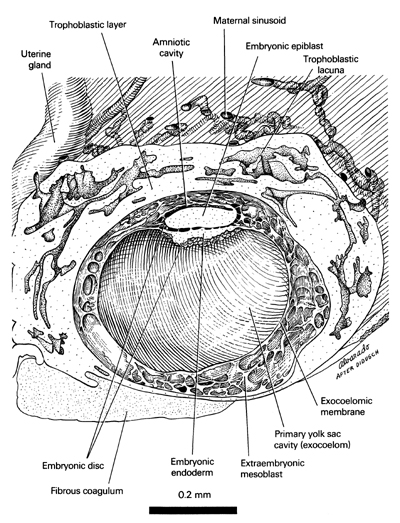
FIG. 2–3
A reconstruction of half of the 12-day embryo (7700) showing its internal features and its relation to maternal sinusoids and a uterine gland. [printable version of FIG 2-3]
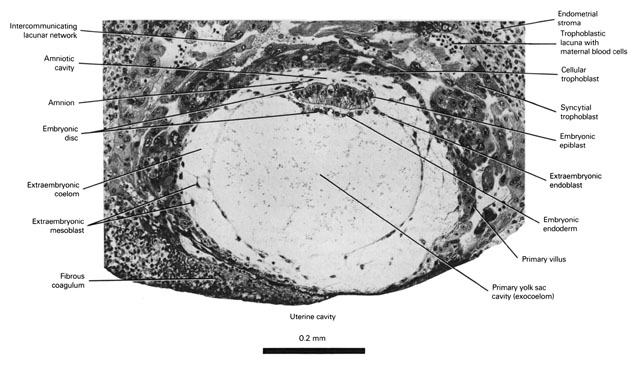
FIG. 2–4
The 12-day embryo with primary villi (late bilaminar blastocyst)
Stage 5
Age 12 days
Carnegie collection 7700
Reference
Hertig AT, Rock J: Two human ova of the pre-villous stage, having an ovulation age of about eleven and twelve days respectively. Contrib Embryol Carnegie Instn 29:127–156, 1941 [printable version of FIG 2-4]
D. AMNION
Early in the second week another membrane known as the amnion begins to form by delamination from the cellular trophoblasts adjacent to the amniotic cleft.
By the end of the week the amnion is composed of an inner thin layer of squamous cells called extraembryonic ectoblasts and an outer covering of extraembryonic mesoblasts. The inner layer is continuous with the epiblast of the embryonic disc and encloses a space above the disc called the amniotic cavity. A small diverticulum called the amniotic duct is a transient structure in the dome of the amnion and has no known function (Figs. 2–5, 2–6, Sect 3).
E. YOLK SAC
Extraembryonic mesoblasts accumulate around the caudal end of the embryonic disc and join it and the adjacent amnion to the cellular trophoblast. The junction area is called the connecting (body) stalk, which is the forerunner of the umbilical cord. It is surrounded by the extraembryonic coelom.
F. ALLANTOIS
A tiny diverticulum called the allantois appears in the caudal wall of the secondary yolk sac. It extends into the connecting stalk and, for the most part, will remain a rudimentary structure.
III. DECIDUAL REACTION
Fig. 2-6, Sect. 1A change called the decidual reaction is produced in the endometrial stroma as a result of the invading trophoblast. The stromal cells enlarge and become pale as glycogen and lipid droplets collect in the cytoplasm.
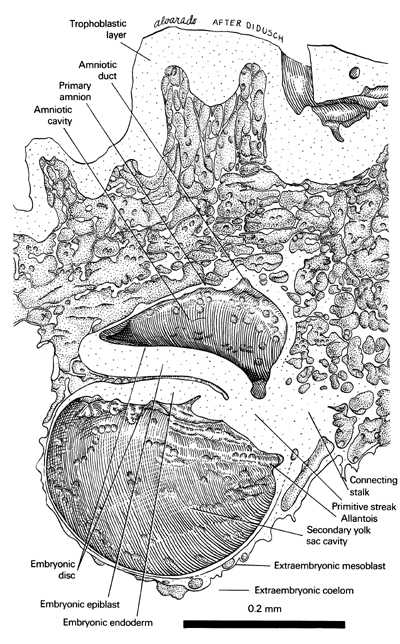
FIG. 2–5
A reconstruction of half of a 13-day embryo (7801) showing the features of the embryo proper and the relations of its extraembryonic membranes (amnion, trophoblast, allantois, yolk sac and connecting stalk). [printable version of FIG 2-5]
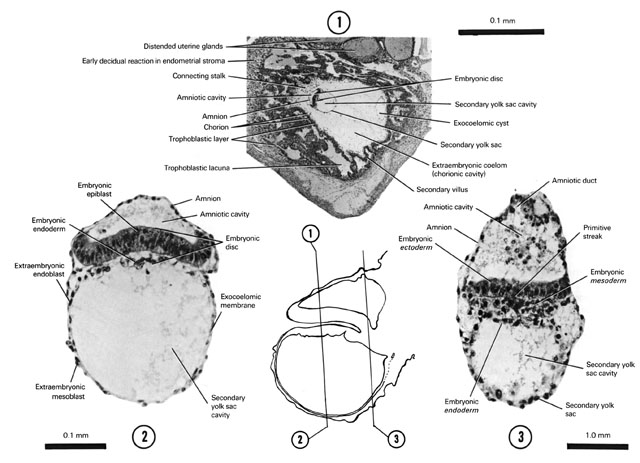
FIG. 2–6
The 13-day embryo with secondary villi (early trilaminar blastocyst)
Stage 6
Age 13 days
Carnegie collection 7801
Reference
Heuser CH, Rock J, Hertig AT: Two human embryos showing early stages of the definitive yolk sac. Contrib Embryol Carnegie Instn 31:85–99, 1945 [printable version of FIG 2-6]
SECTION 1
A section through the middle of the 13-day embryo showing the relation of the embryo to the surrounding endometrium and trophoblastic layer and lacunae.
SECTION 2
A closer view of the embryonic disc in the same section as for Section 1.
SECTION 3
A section through the caudal part of the embryonic disc showing the primitive streak.
